I-MRSEC: Creating a Multidisciplinary Materials Research Community
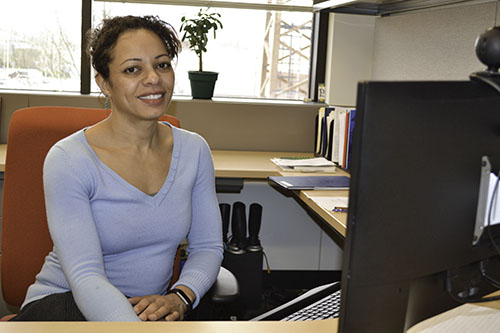
Physics Professor Nadya Mason, PI of the I-MRSEC grant.
March 15, 2018
Begun in September 2017, I-MRSEC (Illinois Materials Research Science and Engineering Center) seeks to create a community around multidisciplinary materials science research; recruiting; educating the next generation of researchers, including diverse students; and informing the general public through outreach. Funded through NSF’s Materials Division, the center will receive $16 million over the six years of the grant, with the possibility of being renewed.
I-MRSEC has two goals: 1) innovative interdisciplinary materials research with applications to societal needs, and 2) interdisciplinary education and training of students in materials design, understanding, and application.
According to the PI, Physics Professor Nadya Mason, the Center’s overarching goal is to create a materials research community. “It's not just about doing the best research, though that's incredibly important, but it's also about training the next generation and creating an environment where materials research is central." She further defines what she means by community.
"So that means that you have collaborations, both interdisciplinary and international,” Mason says. “You have educational components, where you give enhanced opportunities for seminars and classes for the students in the group. It also means that you reach out to the community, both for the sake of educating the community and as a way to bring more people into materials research. The people involved in the grant also get to learn the importance and relevance of reaching out and having other people share the knowledge and appreciate what they are doing."
Mason reports that another important aspect of MRSEC is its interdisciplinary nature: “It has to take a research problem that requires a group of scientists in different fields to solve.” So in addition to PI Mason, twelve faculty not only in Physics, but Materials Science, Mechanical Engineering, Electrical Engineering, and also Chemistry, are involved with I-MRSEC.
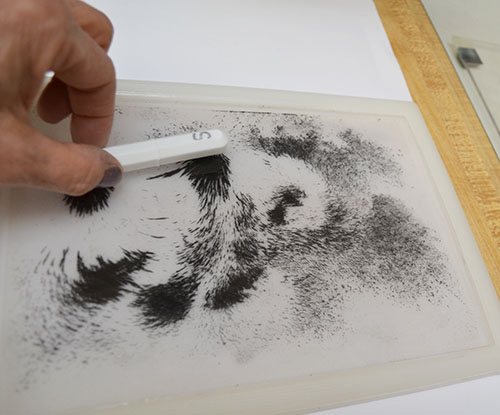
An EOH visitor to the I-MRSEC Magnetism table makes a design using a magnet and iron shavings.
Mason recalls that in previous iterations of the proposal which had not been funded, they had picked the team members and then come up a problem based on the team's members. This time around, the key to their success in getting the grant was this: they sought to “Start with a well-defined problem and build the team around that."
When writing the grant, the campus community was asked to come up with ideas for research, then a panel of experts was convened to judge these proposals to determine which were most viable for the grant.
She goes on to describe the two interdisciplinary research thrusts the teams came up with. The first is magnetic materials with anti-ferromagnetic properties. According to Mason, these materials “won't stick to your fridge, but can be used in computers to store information.”
The second is very flexible, small-scale materials. Mason indicates that there is a need for soft, flexible electronics that can interface with biological material. “We want electronics to interface with our bodies,” Mason explains.
Comprised solely of Illinois faculty, the Center has already established some industry collaborations and hope to implement some international ones, along with collaborating with other campus folks as well.
The Center’s second goal is interdisciplinary education—training students in materials design, understanding, and application. Educational outreach is also another aspect of the grant that Mason is passionate about.
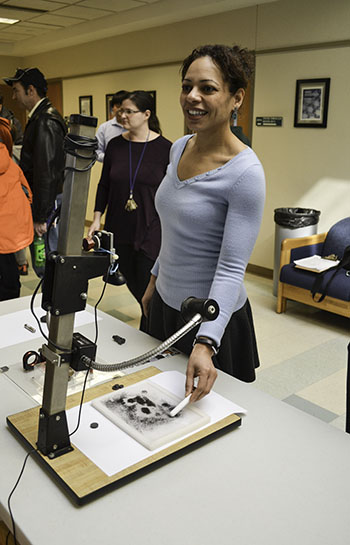
Nadya Mason tries out an I-MRSEC magnetism activity at the MRL Open House.
"Educational outreach is completely integral to the MRSEC,” she says, “and it's what really appeals to me about it. It's not just another research grant."
Key to the education component is communication, another I-MRSEC emphasis:
“Our outreach focus at MRSEC is improving scientific communication,” Mason explains. “We decided that, as a community, we lacked communication skills at all levels, from students to faculty, both technically (giving clear talks to colleagues and peers), to non-technically (just telling the community what we are doing.)
So I-MRSEC hopes to create a cadre of researchers and students who can “effectively communicate their science in different ways,” to not only make an impact but also to create a paradigm for “how to improve this in the scientific community as a whole.”
Thus, I-MRSEC hopes to improve communication as they incorporate several educational/training components over the next year.
Formal Practice Symposium. One aspect of training and communication is for I-MRSEC students to learn how to give presentations and have a chance to practice their skills. So on March 2nd, a Formal Practice Symposium allowed I-MRSEC’s students to practice for the APS (American Physical Society) Conference held in March every year. Both students and faculty go, and in addition to faculty being invited to give talks; students also submit abstracts, and, if they're accepted, give 10-minute talks.
“It's a really big deal for them to go to a conference like this because it is an international audience; researchers from all over world meet for this” explains Pamela Pena Martin, I-MRSEC's Outreach Coordinator. So the practice symposium was created in order to give students a chance to do just that. “They are timed,” she explains, “there are questions from the audience, and we will have another I-MRSEC researcher give them an evaluation with suggestions on how to improve it."
Materials Research Lab Open House. One of the Center's first outreach events involved participating in MRL’s first-ever Open House on March 9th and 10th. There, I-MRSEC-funded graduate students presented exhibits related to I-MRSEC's research emphases; one on magnetism; the other on Topology, during which visitors could make a Mobius strip.
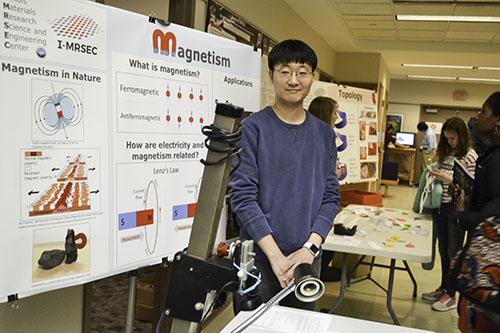
Youngseok Kim, a PhD student waits to talk about magnetism to visitors at the MRL Open House.
Youngseok Kim, a 4th-year Ilinois PhD student studying the numerical and theoretical perspectives of magnetic materials, shares why he participated.
"It's always exciting to teach new information to kids, especially about magnetism,” says Kim. “Kids are so excited, because it’s not something that you can see with your bare eyes, but they can interact with it and visualize what the magnetic field looks like. It's really meaningful to teach these kinds of things and ignite their interest in the STEM fields."
Another I-MRSEC PhD student, Kathleen Oolman, shares why she got involved. "I like explaining science to school-age kids in a way that they can understand. Often, I think science, and especially physics, is this very big and complicated subject and can be very intimidating. So I like being able to explain it in a way that people can understand and relate to. Then maybe that leads someone to have an interest in science and hopefully to be a scientist one day."
Research Videos. One unique education outreach project the I-MRSEC team intends to tackle this spring is a scripted, three-episode video series featuring diverse junior high students who come to a lab and learn about MRSEC research. More than a documentary, the scripted series, “will help the students that watch it, who are interested in the videos, to be engaged with the characters and follow them from episode to episode” explains Pena Martin.

Kathleen Oolman, a Physics PhD student explains an activity to visitors at the MRL Open House.
The videos will also introduce young viewers to scientists, so they might be able to also see themselves as scientists, and will also include science research teachers can use. For instance, after the episodes will be clips about the science and the people behind it, who will talk about why they're interested in science.
“I think if they see a scientist talking about what they're passionate about, even something not science related,” Pena Martin adds, “it might make a student realize that they can still be a scientist with these different interests and how those interests might affect how they are as a scientist."
The videographer, who will also be writing the script, has experience doing science videos and working with students of this age. Plus, to ensure that the videos impact under-represented students, the students will be intentionally cast so that they reflect diverse backgrounds.
Scientific Communication Workshop. In keeping with I-MRSEC’s communication emphasis, on May 18th, I-MRSEC is holding a workshop presented by Stonybrook's Alda Center for Scientific Communication .
The workshop is based on the work of Alan Alda, star of the TV series M.A.S.H., who, after doing a PBS series about interviewing scientists, came up with a concept regarding how to communicate science so that people can understand.
I-MRSEC REU. One outreach program I-MRSEC will begin this summer, May 29th–Aug 3rd, is its Research Experience for Undergraduates (REU) program, which will expose eight non-University-of-Illinois students to ten weeks of multi-disciplinary materials research.
According to Pena Martin, coordinator of the REU, the goal is to give research experiences to students who may not have access to these opportunities. So they are seeking to foster diversity, specifically targeting under-represented minorities, women, people with disabilities, and first-generation students.
Plus, Pena Martin’s also hoping that they continue on and go to graduate school at Illinois too. “If they come here, that would be really wonderful too," she admits.
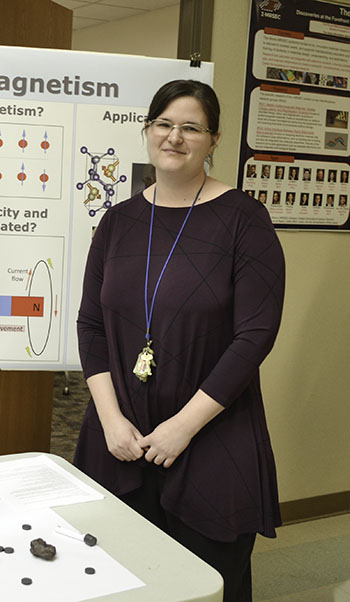
I-MRSEC Outreach Coordinator, Pamela Pena Martin.
Still under development, the REU programming might include weekly student-faculty luncheons, an end-of-the-summer event, possibly a final poster presentation, plus they hope to coordinate some activities with Physics and Chemistry’s REUs. Also, while their REU participants will not be partnering with SROP, they hope to take advantage of SROP’s programming.
And to prepare their graduate students to serve as mentors for the REU participants, I-MRSEC intends to hold a graduate student mentor training in May.
Pena Martin says one over-arching goal of their outreach activities is to get young people, especially underrepresented students, to choose STEM careers, including research.
“For me, I feel like students don't have the opportunities to see themselves as scientists. So when they start to make decisions about their plans for their education later on, they don't even consider it. I didn't when I was younger. I decided to study physics after I was already an undergraduate...I think students don't get it because they don't see themselves as scientists, because they don't see it reflected in media.”
She also hopes to show that scientists “are just normal everyday people. People who do science and enjoy other things. I'm a scientist, and I have interests outside the lab. Kids being able to see that scientists are real people that can be is really important... Math may be difficult for you, but you can still be a scientist, and that it might make you a better scientist."
PI Mason adds that the education/outreach components are also important to ensure the community’s continuity. "We want students to be able to continue this research in the future, long after the current researchers are gone. We want people in the community to understand what their friends and neighbors are working on and appreciate it and maybe inspire others to enter the field. We want people to go to politicians and the media and even just be walking down the street and say, 'Yeah, materials research is really great and cool!'"
Story and photos by Elizabeth Innes, Communications Specialist, I-STEM Education Initiative.
More: Chemistry, ECE, Externally Funded, I-MRSEC, MatSE, Open House, Physics, REU, Science Center, 2018
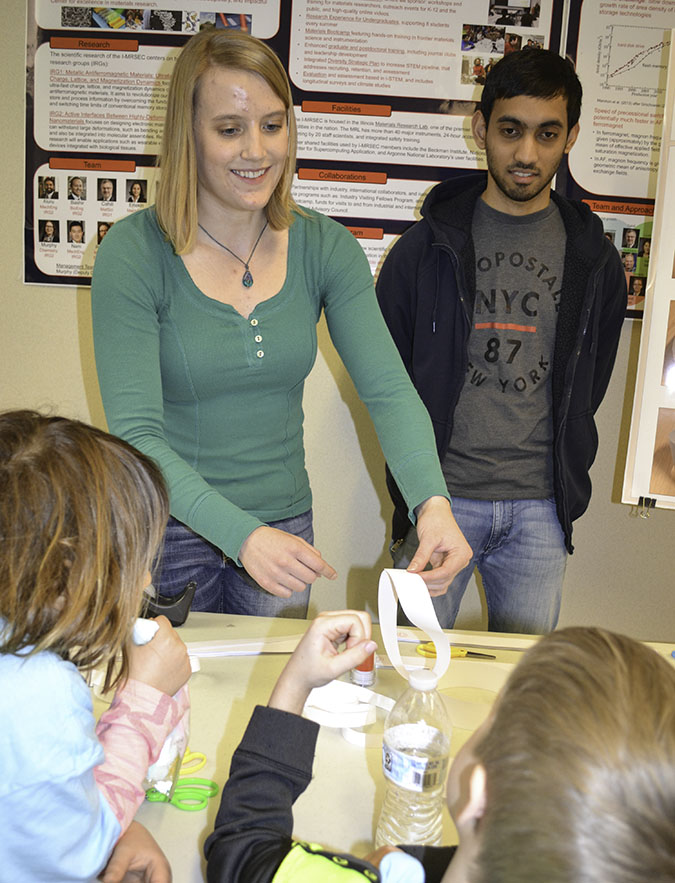
PhD students work through an activity with visitors at the MRL Open House.













.jpg)
















